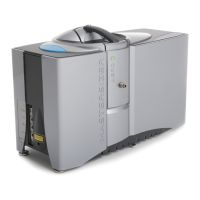Chapter 5 Viewing measurement results
Page 5-12 MAN 0474
residual of over 1% may indicate use of incorrect refractive index and absorp-
tion values for the sample and dispersant.
The statistics of the distribution are calculated from the results using the
derived diameters D[m,n] – an internationally agreed method of defining the
mean and other moments of particle size. See British standard BS2955:1993 for
more details.
Dv 50, Dv 10 and Dv 90 are standard percentile readings from the analysis.
Dv 50 – the size in microns at which 50% of the sample is smaller and 50%
is larger. This value is also known as the Mass Median Diameter (MMD)
or the median of the volume distribution. The v in the expression Dv 50
shows that this refers to the volume distribution. This can be replaced by s
for surface, l for length or n for number distributions.
Dv 10 – the size of particle below which 10% of the sample lies.
Dv 90 – the size of particle below which 90% of the sample lies.
D[4,3] – the Volume Weighted Mean or Mass Moment Mean Diameter,
also known as the De Broucker mean.
D[3,2] – the Surface Weighted Mean, also known as the Surface Area
Moment Mean Diameter or Sauter mean.
Span – is the measurement of the width of the distribution. The narrower the
distribution, the smaller the span becomes. The span is calculated as:
The x is replaced by any of the letters v, s, l or n that define the distribution
type.
Concentration – the volume concentration. This is calculated using Beer-
Lambert’s law. For full details see the following section.
Obscuration – this helps the user to set the concentration of the sample when
it is added to the dispersant. It is a measure of the amount of laser light lost due
to the introduction of the sample into the analyser beam.
The obscuration term can be expressed mathematically:
Dmn
V
i
d
i
m 3–
V
i
d
i
n 3–
---------------------------
1
mn–
-------------
=
Span
dx0.9dx0.1–
dx0.5
------------------------------------------------
=

